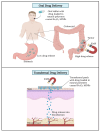The State of the Art of Natural Polymer Functionalized Fe3O4 Magnetic Nanoparticle Composites for Drug Delivery Applications: A Review
- PMID: 36826291
- PMCID: PMC9957034
- DOI: 10.3390/gels9020121
The State of the Art of Natural Polymer Functionalized Fe3O4 Magnetic Nanoparticle Composites for Drug Delivery Applications: A Review
Erratum in
-
Correction: Nordin et al. The State of the Art of Natural Polymer Functionalized Fe3O4 Magnetic Nanoparticle Composites for Drug Delivery Applications: A Review. Gels 2023, 9, 121.Gels. 2024 Jan 15;10(1):64. doi: 10.3390/gels10010064. Gels. 2024. PMID: 38247797 Free PMC article.
Abstract
Natural polymers have received a great deal of interest for their potential use in the encapsulation and transportation of pharmaceuticals and other bioactive compounds for disease treatment. In this perspective, the drug delivery systems (DDS) constructed by representative natural polymers from animals (gelatin and hyaluronic acid), plants (pectin and starch), and microbes (Xanthan gum and Dextran) are provided. In order to enhance the efficiency of polymers in DDS by delivering the medicine to the right location, reducing the medication's adverse effects on neighboring organs or tissues, and controlling the medication's release to stop the cycle of over- and under-dosing, the incorporation of Fe3O4 magnetic nanoparticles with the polymers has engaged the most consideration due to their rare characteristics, such as easy separation, superparamagnetism, and high surface area. This review is designed to report the recent progress of natural polymeric Fe3O4 magnetic nanoparticles in drug delivery applications, based on different polymers' origins.
Keywords: animal; composites; drug delivery; magnetic nanoparticles; microbe; natural polymer; plant.
Conflict of interest statement
The authors declare no conflict of interest.
Figures














References
-
- Hrubý M., Filippov S.K., Štěpánek P. Smart polymers in drug delivery systems on crossroads: Which way deserves following? Eur. Polym. J. 2015;65:82–97. doi: 10.1016/j.eurpolymj.2015.01.016. - DOI
-
- Jain K.K. Drug Delivery Systems—An Overview. Humana Press; Totowa, NJ, USA: 2008. pp. 1–50. - PubMed
-
- Gopi S., Amalraj A., Thomas S. Effective drug delivery system of biopolymers based on nanomaterials and hydrogels—A review. Drug Des. 2016;5:2169-0138. doi: 10.4172/2169-0138.1000129. - DOI
Publication types
LinkOut - more resources
Full Text Sources

